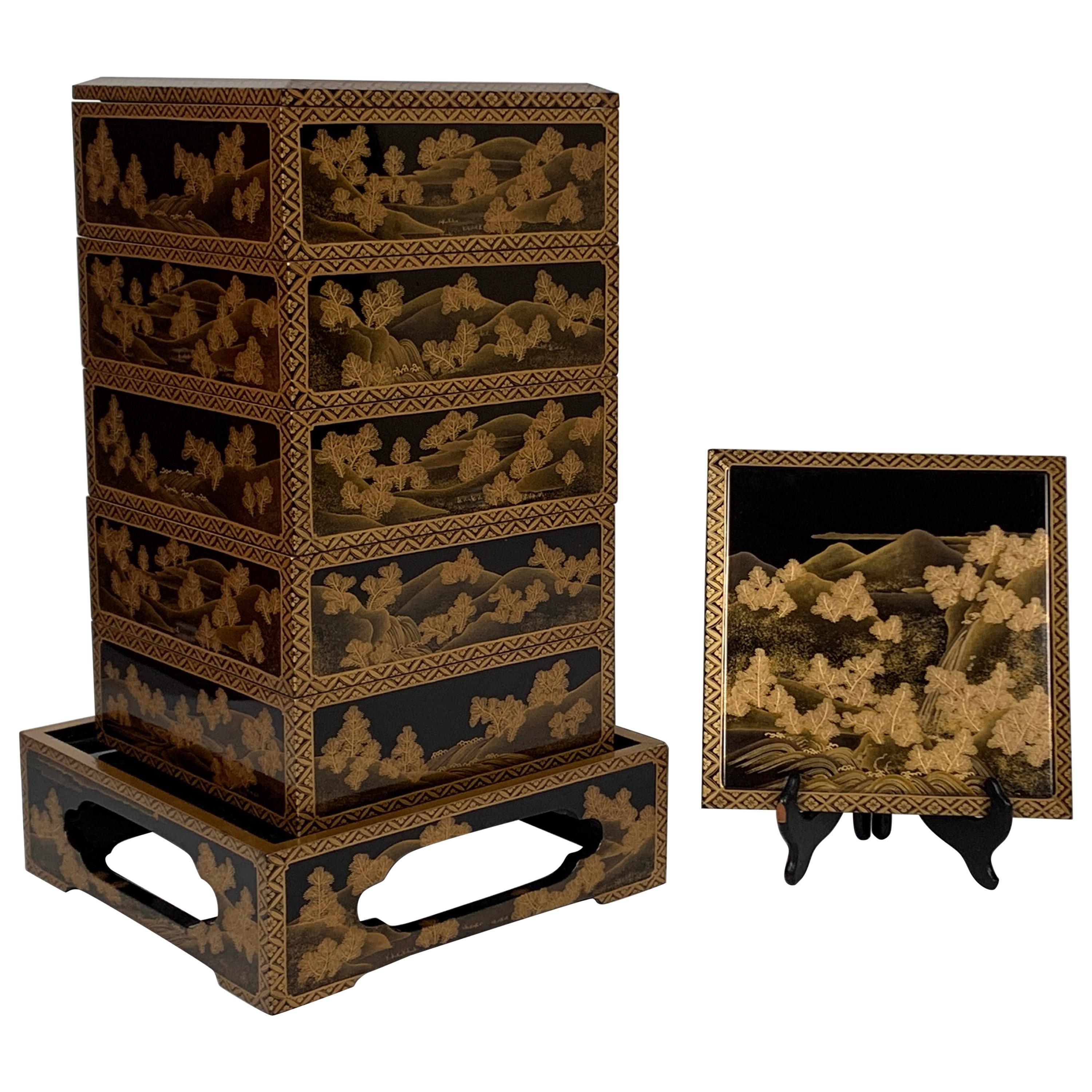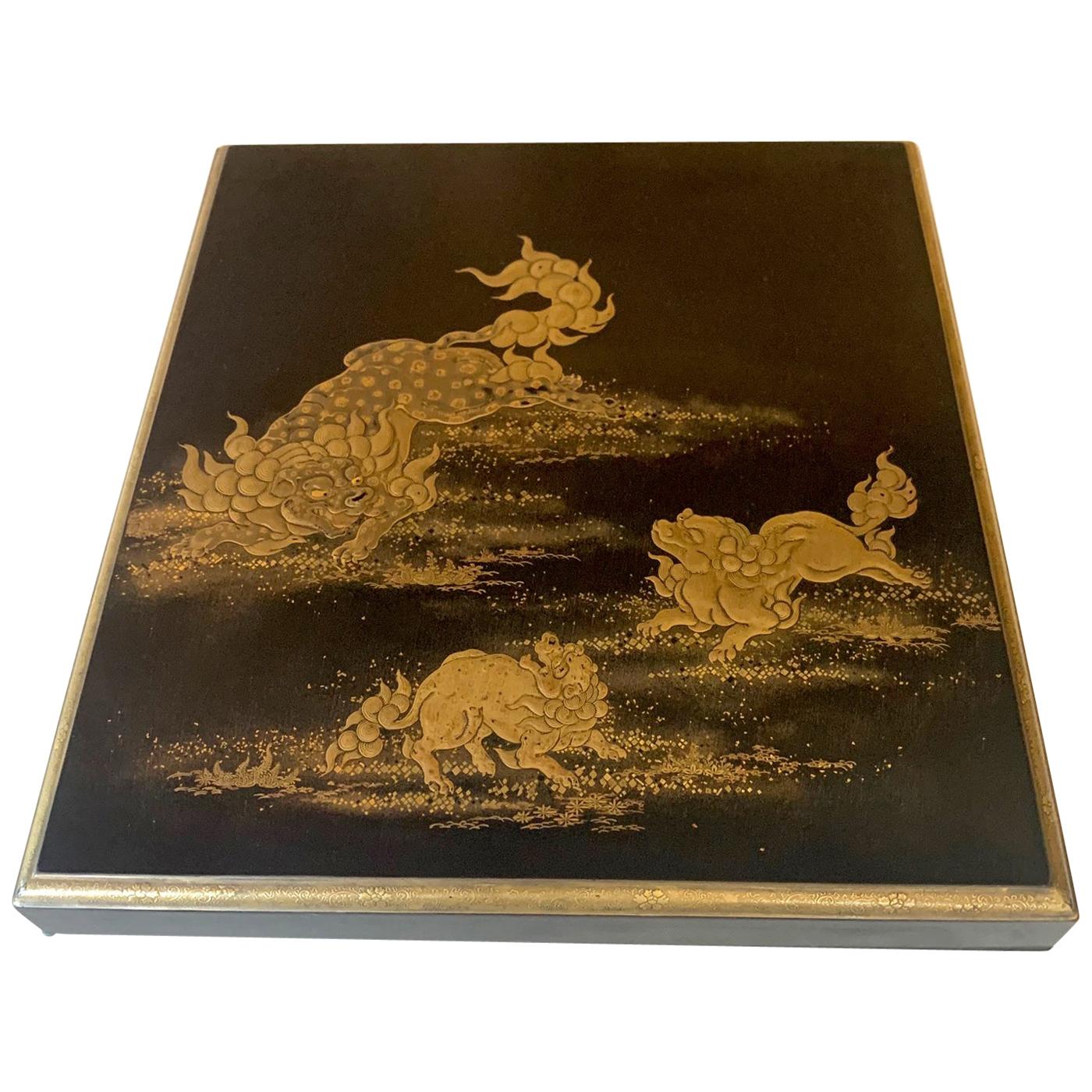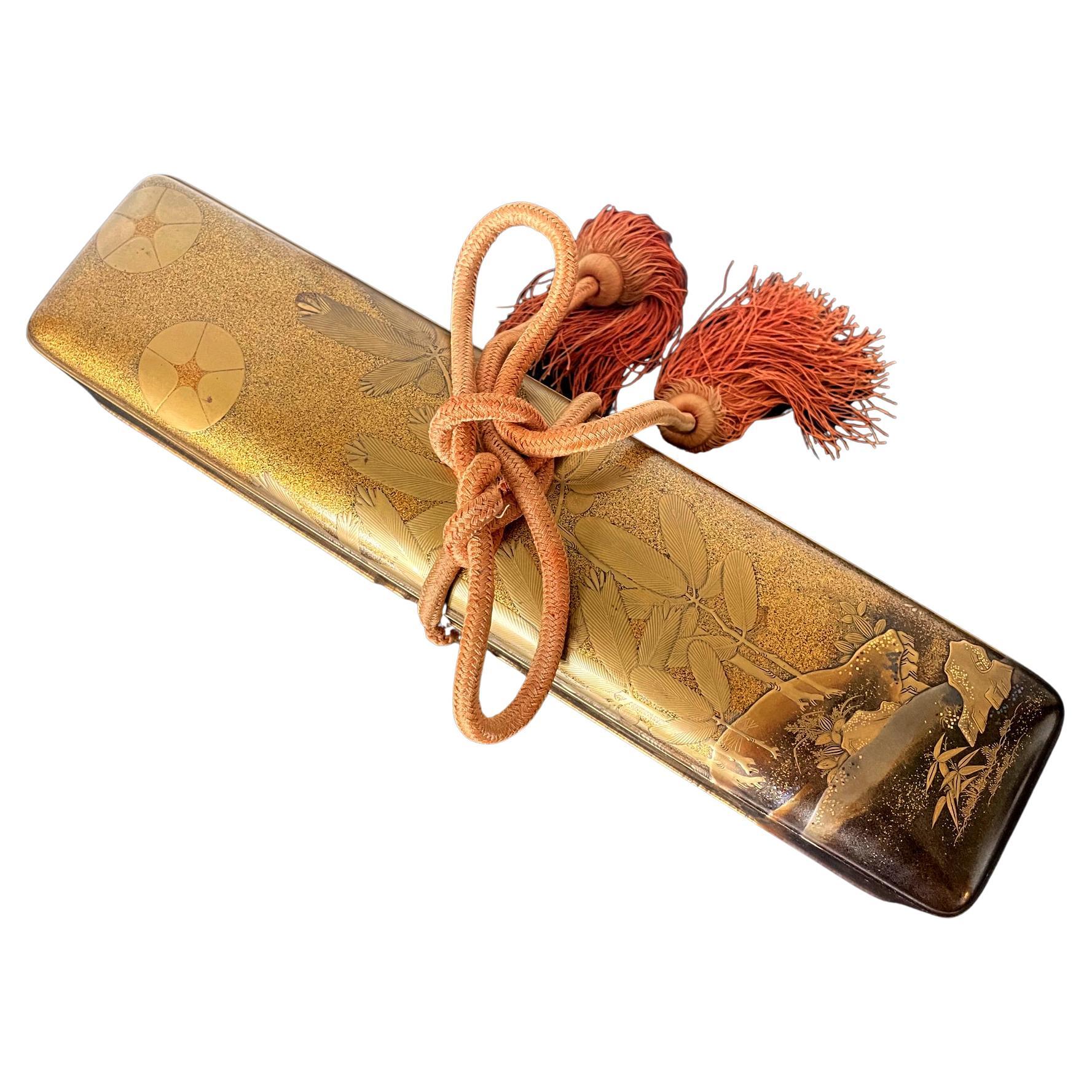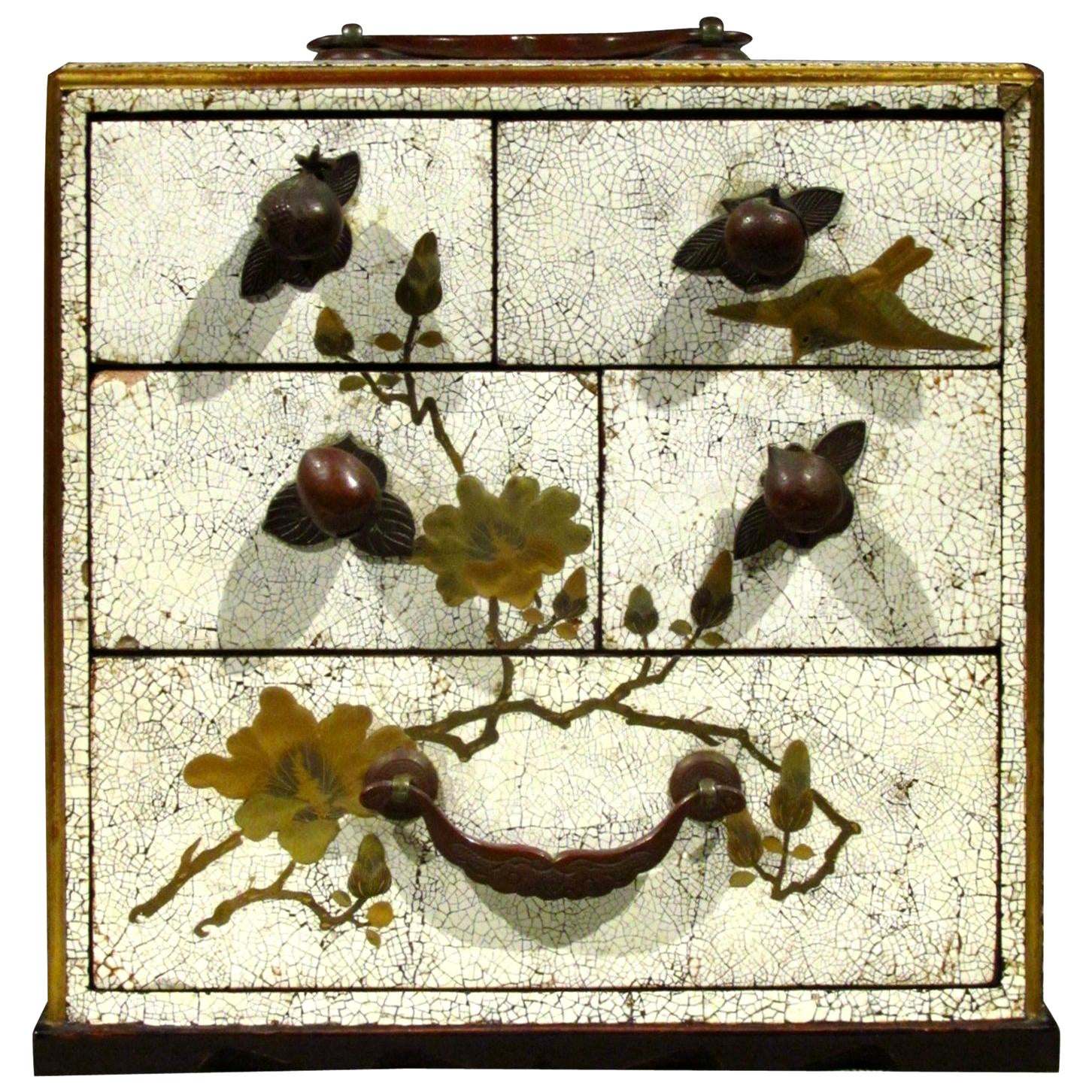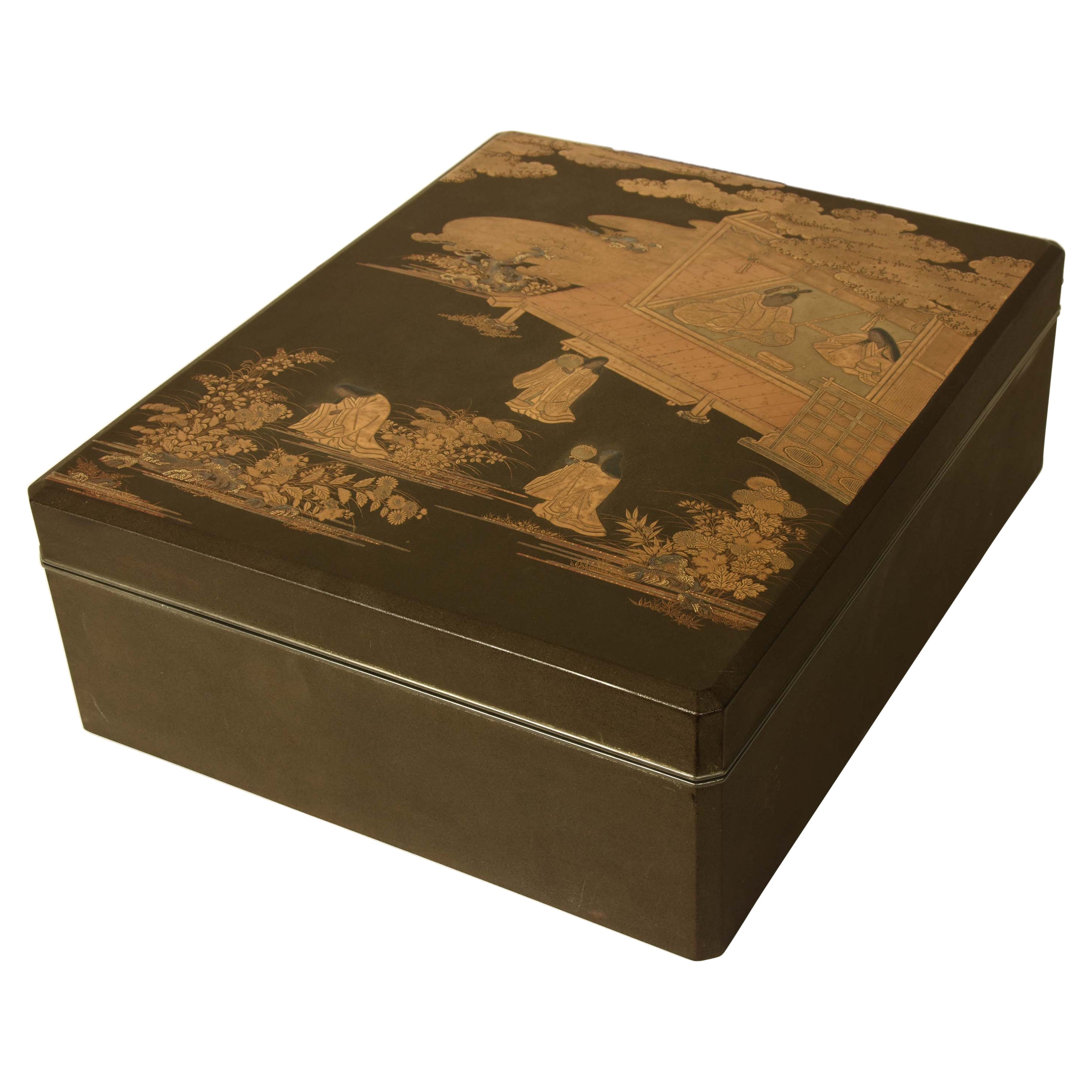Items Similar to Japanese Maki-e Lacquer Sutra Box with Peony Mon, Meiji Period, c 1900, Japan
Want more images or videos?
Request additional images or videos from the seller
1 of 16
Japanese Maki-e Lacquer Sutra Box with Peony Mon, Meiji Period, c 1900, Japan
About the Item
A Japanese maik-e decorated black lacquer sutra box, kyobako, with peony mon design, Meiji Period, circa 1900, Japan.
The elegant lacquer box originally crafted to hold sutras, sacred Buddhist texts. Of rectangular shape, the lacquer box features a flush fitting lid with beveled edges, gilt copper mounts, and a design of family crests, mon, against a geometric "hishi" ground.
The family crests, mon, are in the form of a large peony blossom with two upward curving leafy branches terminating in buds. The peony mon design is exquisitely worked, with fine lines and details. This form of the peony mon is associated with the Araki clan. The peony motif is further engraved on the gilt copper fittings.
The peony mon rest upon a geometric ground in the "hishi" pattern. Often interpreted as water chestnut flowers, this pattern symbolizes prosperity.
The interior of the box wonderfully decorated in stunning nashiji (lit. pear skin) evocative of fog or clouds. The underside of the box further decorated in a simpler nashiji.
- Dimensions:Height: 4 in (10.16 cm)Width: 9 in (22.86 cm)Depth: 10.25 in (26.04 cm)
- Style:Meiji (Of the Period)
- Materials and Techniques:
- Place of Origin:
- Period:1900-1909
- Date of Manufacture:circa 1900
- Condition:Wear consistent with age and use. Minor losses. Minor structural damages. Minor fading. The box presents very well. The lid slightly warpped. One corner of the lid with slight loss. Minor scratches to the surface. The interior of the lid with losses at the corners. The underside of the box with scratches.
- Seller Location:Austin, TX
- Reference Number:1stDibs: LU894739819792
About the Seller
5.0
Platinum Seller
These expertly vetted sellers are 1stDibs' most experienced sellers and are rated highest by our customers.
Established in 2001
1stDibs seller since 2010
310 sales on 1stDibs
Typical response time: 1 hour
- ShippingRetrieving quote...Ships From: Austin, TX
- Return PolicyA return for this item may be initiated within 7 days of delivery.
More From This SellerView All
- Japanese Maki-e Lacquer Stacking Box, Jubako, Meiji Period, JapanLocated in Austin, TXA fine and impressive Japanese gold maki-e decorated black lacquer five-tier jubako with presentation tray, two lids, and the original tomobako storage box, Meiji period, late 19th c...Category
Antique Late 19th Century Japanese Meiji Lacquer
MaterialsLacquer
- Large Japanese Lacquer Document Box, Ryoshibako, Edo/Meiji period, JapanLocated in Austin, TXA large and magnificently decorated Japanese lacquer document box, ryoshibako, signed Umeboshi/Baikyo, late Edo or early Meiji Period, mid 19th century, Japan. The large document box, ryoshibako, of tall, rectangular shape with rounded corners, and fitted with an inrobuta (flush-fitting) cover with beveled edges. The exterior of this exquisite box is decorated all over with fifteen different raised reserves shaped as uchiwa (paddle) fans against a lush and intricate krikane ground imitating shagreen. The uchiwa shaped reserves all of takamaki-e, and exquisitely painted with designs of animals, flowers, and landscapes in silver, gold, maki-e, hiramaki-e, and takamaki-e, with kirikane, nashiji, and polychrome embellishments, upon gold lacquer fudame grounds. The interior of the lid is nothing short of spectacular, featuring a large design of a magnificent and beautifully detailed rooster and hen with chicks gathered around a lazy stream. Large stalks of chrysanthemum bloom behind them. All against an ethereal nashiji ground. The cover of the box features five reserves: 1. Three minogame (turtles with long tails), symbolizing longevity 2. "Narihira Crossing the Sumida" from The Tales of Ise...Category
Antique 1860s Japanese Meiji Lacquer
MaterialsSoftwood, Lacquer
- Japanese Lacquer House Shaped Incense Box, Kogo, Meiji Period, JapanLocated in Austin, TXA delightful and intricately decorated lacquer box for storing incense, kogo, in the form of a traditional farm house, Meiji period (1864 - 1912), late 19th century, Japan. The kogo, or small box for storing incense, takes the whimsical form of a traditional Japanese home, minka, with the removable high, thatched roof serving as the cover for the box. The exterior of the home has been painstakingly decorated in maki-e lacquer against a matte black lacquer ground. Traditional shoji doors, bamboo blinds...Category
Antique Late 19th Century Japanese Meiji Lacquer
MaterialsLacquer
- Japanese Marquetry and Lacquer Jewelry Chest, Meiji Period, circa 1900, JapanLocated in Austin, TXA very attractive Japanese wood table top jewelry or collector's chest with marquetry and lacquer decoration, Meiji period, circa 1900, Japan. Previously in the collection of Asbjorn Lunde (1927 - 2017). The chest is crafted in the form of a Chinese seal...Category
Antique Early 1900s Japanese Meiji Lacquer
MaterialsWood, Softwood, Lacquer
- Japanese Maki-e Lacquer Document Box, Edo Period, early 19th Century, JapanLocated in Austin, TXA spectacular Japanese maki-e lacquer lidded box, possibly a writing box, suzuribako, decorated with images of folding fans, ogi, Edo Period, earl...Category
Antique Early 19th Century Japanese Edo Lacquer
MaterialsCoral
- Japanese Lacquer Hibachi with Imperial Chrysanthemum, Meiji Period, JapanLocated in Austin, TXA simple and elegant Japanese lacquer hibachi stand with imperial chrysanthemum mon and copper liner, now modified as an usubata, late Meiji Period, ci...Category
Antique Early 1900s Lacquer
MaterialsCopper
You May Also Like
- Japanese Meiji Period Antique Lacquer Box with Gold Maki-e DecorationLocated in New York, NYA fine antique Japanese Meji Period lacquer box decorated with a fan and a stylized star shaped window in the maki-e technique. The fan at the top right corner, fully opened depictin...Category
Antique 19th Century Japanese Meiji Lacquer
MaterialsLacquer
- Japanese Lacquer Box with Fine Maki-e Decoration Meiji PeriodLocated in Atlanta, GAA lacquered wood box with lid from Japan circa 19th century Meiji Period. The finely decorated box was used to store paper slips and small documents on the desk. It is overall finished with black lacquer (kuro) with sparse Mura-Nashiji effect outside and on the top surface of the lid, there are three Komainu, (sometimes known as Shishi or Japanese lions) frolicking and forming a circle in lively motion. Komainu are auspicious animals in Japanese cultures in both Shinto and Buddhism tradition. Originally from China, these animals symbolizes guardians to ward off evil spirits. Hiramaki-e was used in combination with carving and combing to render the lions with various surface textures. A gilt border with an slight angle was given to the lid and even the thin band is decorated with miniature floral scrolls. The interior of the box was finished in a dense nashiji. Underneath the lid, a cluster of peonies open lavishly by two gentle mounts. Takamaki-e (high relief) in both gold and silver were...Category
Antique Late 19th Century Japanese Japonisme Lacquer
MaterialsWood, Lacquer
- Japanese Lacquered Gold Maki-E Naga Fubako Meiji PeriodLocated in Atlanta, GAA Japanese lacquered wood Naga Fubako (a long box used to store document or large scroll painting), circa 19th century Meiji period. The rectangular box features an unusually deep lipped lid with slightly rounded corners, a conforming lower box with bronze medallion rings with tasseled...Category
Antique 19th Century Japanese Meiji Lacquer
MaterialsWood, Lacquer
- Signed Japanese White Lacquer and Maki-E Lacquer Tansu, Meiji PeriodLocated in Ottawa, OntarioThe case decorated overall in crackle-glaze white lacquer and fitted with a patinated metal carrying handle over three tiers of small drawers. The first two tiers are comprised of a ...Category
Antique Late 19th Century Japanese Meiji Lacquer
MaterialsLacquer
- Japanese Black Lacquer Document Box with Gold Maki e Design, Meiji PeriodLocated in Prahran, VictoriaAn antique black lacquer document box with an exquisitely detailed, finely wrought design from The Tale of the Genji depicted in gold maki e across the lid. Internally, the box is de...Category
Early 20th Century Japanese Lacquer
MaterialsWood, Lacquer
- Japanese Lacquer Maki-e Sake Ewer Meiji PeriodLocated in Atlanta, GAA Japanese lacquered wood sake ewer with maki-e design, circa late 19th century, Meiji period. The nicely decorated lacquerware is of a Classic sake ewer for...Category
Antique 1890s Japanese Japonisme Lacquer
MaterialsLacquer
Recently Viewed
View AllMore Ways To Browse
Antique Peony
Antique Lit
Buddhist Japan
Buddhist Flowers
Japanese Inlay
Japanese Black Lacquer Gold
Japanese Black And Gold Lacquer
Japan Edo Lacquer
Japanese Gilt Lacquer
Japanese Lacquer Edo
Mons Antique
Gold Asian Black Lacquer With Gold
Black Lacquer Box Asian
Pair Japanese Lacquer
Cinnabar Furniture
Pair Of Japanese Lacquer
Mother Of Pearl Black Lacquer
Black Lacquer Mother Of Pearl
